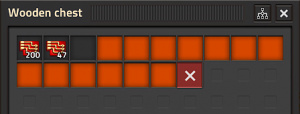User talk:JakubSTR
Welcome to the Official Factorio Wiki! Now that you have an account, there are a few key places on this Wiki that will be helpful in your efforts to improve it.
First and foremost, please be sure to read and understand the rules of this Wiki. If you have any questions or concerns with these rules, please don't hesitate to ask an Admin.
Secondly, if you're new to editing Wikis and are unfamiliar with MediaWiki's formatting, please be sure to read the help pages. In addition to the help provided by MW, we also provide a style guide that we enforce.
If you're unsure where to begin, please see the editor noticeboard, where information on the current objectives and projects of the Wiki may be found.
Again, welcome, we hope you contribute as much high quality information as you can. :) Bilka (talk) - Admin 10:58, 6 February 2018 (UTC)
Linki
https://wiki.factorio.com/index.php?title=Special:AllPages&namespace=10
https://wiki.factorio.com/Factorio:Editor_noticeboard
https://wiki.factorio.com/Factorio:Wanted_pages/pl
Templatesy https://wiki.factorio.com/index.php?title=Special:AllPages&namespace=10
Stosy
Stos to podstawowe miejsce, w którym znajdują się przedmioty (wydobyte lub wyprodukowane). W jednym stosie mogą znajdować się jednakowe przedmioty o zdefiniowanej liczbie. Każde miejsce, w którym może znajdować się przedmiot ma określon maksymalną liczbę stosów (co dalej definiuje pojemność na dany przedmiot).
Przykłady ekwipunków
- Ekwipunek gracza:
- Główny ekwipunek
- Pasek narzędziowy
- Zasobnik uzbrojenia, broni i amunicji
- Miejsce logistycznego wywozu
- Ręka gracza
- pojazdy:
- Skrzynie: Skrzynie to zbiór stosów.
- Urządzenia
- Piece: Stos na paliwo (Tylko kamienny i stalowy piec), stos na surowce i stos na produkty
- Automat montażowy oraz Zakład chemiczny: 1 lub więcej wyjściowych oraz 1-6 wejściowych stosów, zależne od rodzaju produkcji w danym urządzeniu
- Laboratoria
- Spalinowe: Bojler, Spalinowa wiertnica górnicza, spalinowy podajnik
- Roboport (tylko dla robotów i zestawów naprawczych)
- Działko maszynowe
- Specjalne
- Podajniki oraz roboty (Małe, zmienne stosy, pozwalające na transport przedmiotów pomiędzy "normalnymi" stosami. Rozwijając badania: Zwiększona ładowność podajników oraz Pojemność robotów technicznych)
Jak działają stosy
Stos przechowuje określoną liczbę jednakowych przedmiotów.
Pierwszy włożony przedmiot determinuje, jaki przedmiot w danym stosie będzie przechowywany. Definiuje również, jak dużo przedmiotów może być przechowywanych w stosie, ponieważ to zależy od maksymalnego rozmiaru stosu dla danego przedmiotu.
Tylko przedmioty mogą być przechowywane w stosach. Nie można przechowywać płynów w stosach.
Wielkość stosu
Maksymalna liczba przedmiotów danego typu w stosach. Poniżej przedstawiono przykłady (kliknij, aby rozwinąć):
| Wielkość stosu | Przemiot (przykłady) |
|---|---|
| 1 | Nuclear fuel, Artillery shell, Satellite, Modular armor, Blueprint. |
| 5 | Locomotive, wszystkie Wagony. |
| 10 | Roboport, Rocket fuel, Artillery turret, Atomic bomb. |
| 20 | Niektóre Equipment modules, Pumpjack, Steel axe. |
| 50 | Wszystkie rudy, Stone, Coal, wszystkie [[Module|]], Electric mining drill, Electric furnace, wszystkie Assembling machine, wszystkie Chests, wszystkie Inserters, Gun turret, Laser turret, wszystkie Power poles oraz Substation, roboty techniczne, Solid fuel. |
| 100 | Iron plate, copper plate, steel plate, processing unit, iron gear wheel, stone brick, all types of concrete, both isotopes of processed uranium, pipe (regular), all belts, stone wall, landfill. |
| 200 | Electronic circuit, advanced circuit, Copper cable, czerwony oraz zielony przewód, wszystkie Science pack oprócz space science pack |
| 2,000 | Wyłącznie dla space science pack. |
Filtrowanie stosów
Stosy są filtrowane domyślnie w obiektach spalinowych (można tam włożyć tylko paliwo), roboportach (roboty i zestawy naprawcze), laboratoriach (pakiety naukowe), automatach montażowych (w zależności od typu produkcji). Stos może być filtrowany przez gracza (Template:Keybindings), ale tylko dla wagonu towarowego oraz w pasku narzędziowym gracza. W przypadku skrzyń filtrowanie nie jest możliwe.
Filtrowanie może być użyte dla zapewnienia konkretnego przedmiotu w przestrzeni magazynowej. Dzięki temu, podajniki i roboty, nie włożą nic co nie odpowiada filtrowi. Ręczna próba włożenia innego przedmiotu też nie będzie skuteczna, dopóki filtr nie zostanie wyczyszczony.
Damaged items
Damaged items (i.e, damaged entities now stored as items) stack with other damaged items (of the same type), but not with undamaged items. When items with different amounts of damage are stacked together, the health of the items is averaged.
Items with durability
Items with durability, such as science packs and repair packs, always stack with items of the same type, regardless of how much durability remains. The durability displayed on the stack is the durability of the first item. After that item is removed from the stack, a stack of items with full durabilities remains. This means that when multiple items with durabilities are stacked together, their durabilities are merged, which can result in a lower overall item count while the overall remaining durability stays the same.
Stack size bonuses
Inserters and logistic robots can be boosted with research to hold and transfer more items, see:
Stack limitation

Optionally, the usable space in chests and wagons can be decreased below their default values. Typically, this is done to store a small amount of items in an automated process, without consuming the resources that would be required to fill the entire container.
To limit a container, click the red X at the end of the last stack. Then, click on one of the stacks to set the new limit. The unused stacks will be highlighted red (see right).
When full, inserters will no longer add to a limited container. However, the player is still free to manually place items in the unused (red) slots.
Handling stacks
There are some keyboard bindings to quickly handle movement of stacks between inventories, like moving half of a stack to another stack.
History
In game version 0.10, the number of items which can be stored in a stack changed for most items from powers of 2 to multiples of 10. This change was mainly made because most people find it more intuitive to calculate numbers in a base-10 system.
Example: Before the change, a stack could store 64 iron ore, while after the change it is 50. This created some controversy, as some players preferred the old stack sizes.